
10 art exhibitions to see in August
By Robert Heath
Published on 31 July 2017
From an exploration of recent LGBTQ+ art to a vibrant celebration of tulips, here's our pick of the best new exhibitions to see this month.
Coming Out: Sexuality; Gender and Identity
Walker Art Gallery, Liverpool, until 5 November
Coming Out: Sexuality; Gender and Identity is one of several UK exhibitions marking 50 years since the partial decriminalisation of male homosexuality in Britain (two currently on show are Queer British Art at Tate Britain and the display Desire, love, identity at the British Museum). Charting recent LGBTQ+ history through art, this show sets itself apart by focusing specifically on artists working from 1967 onwards. The works explore sexuality and gender across a variety of mediums – including work by Sarah Lucas and Anya Gallacio’s installation Can Love Remember the Question and the Answer? (2003), in which 60 gerbera flowers are inserted into the window panes of a pair of mahogany doors and left to slowly decompose.

Edinburgh Art Festival
Edinburgh, until 27 August
The Edinburgh Art Festival has grown in scope and stature since its establishment in 2004. Now the largest visual art festival in the UK, it comprises over 45 exhibitions in venues ranging from large galleries and museums to artist-run spaces. This year's programme includes major historical exhibitions such as Beyond Caravaggio at the Scottish National Gallery, a variety of smaller exhibitions including one of our July picks – Jac Leirner’s show at the Fruitmarket Gallery – plus talks, tours, walks and film screenings. Unique to the festival is a series of commissions displayed in public spaces that engage with Edinburgh's local history. Artists have created works inspired by the foundation of the Edinburgh Festival in 1947 and the town planner and social theorist Sir Patrick Geddes’s 1917 pamphlet The Making of the Future: A Manifesto and a Project, which put forward a vision for a more holistic society with art and culture at its core.

Turkish Tulips
Bowes Museum, Durham, until 5 November
In the 17th century, tulips were traded between The Netherlands and the Ottoman Empire, and became so sought-after that they caused the world's first speculative financial boom and bust. Curated by contemporary artist Gavin Turk, this exhibition is dedicated to the craze-inducing flower. The show includes new works by Turk himself, in addition to pieces by Royal Academicians including Michael Craig-Martin, Cornelia Parker and Yinka Shonibare. The exhibition, which Turk organised with children’s arts charity The House of Fairy Tales, is interspersed throughout the permanent collection at the Bowes Museum, juxtaposing the flowers with the decorative arts in the collection. Each artist accentuates a different aspect of the flower or a different symbolic association. Craig-Martin’s Tulip (after Mapplethorpe) (2016) echoes the photographer Robert Mapplethorpe’s delicately erotic compositions of flowers, trading Mapplethorpe's typically monochrome palette for his own lurid combination of purple, orange and blue paints.

Now; Today; Tomorrow and Always
Towner Art Gallery, Eastbourne, until 8 October
This group exhibition explores the power of pop culture – showing how its imagery, ideas, language and reception have influenced contemporary art. Now; Today; Tomorrow and Always draws together work by 12 artists, all either British or based in Britain, working across a range of different mediums. Some artists borrow imagery directly from pop cultural artefacts, such as Mario Rossi’s series of five paintings which depict the words "The End", as seen in the closing shots of films such as Psycho and On the Waterfront. Others are more interested in the ways in which pop culture is cherished; Jeremy Deller’s installation The Uses of Literacy (1997) explores fandom surrounding the band Manic Street Preachers by collecting paintings, collages, books and poetry created by their followers.

Picasso: Ceramics from the Attenborough Collection
York Art Gallery, York, until 5 November
Pablo Picasso began producing ceramics when he was in his 60s, following a meeting with potters Georges and Suzanne Ramié, who let him work in their pottery in Vallauris in the South of France. His ceramics were (initially) inexpensive, and caught the eye of Lord and Lady Attenborough, who amassed a collection of over 100 pieces over the course of many annual trips to the region. Works from this collection are now on display at York Art Gallery, shown alongside ceramics from the gallery’s own collection of work by British potters. The distinctive pieces on show, which include plates, jugs and vases, evince Picasso's typically playful attitude. They are often adorned with faces as in the case of Vase Aztèque Aux Quatre Visages (1957), an Aztec-style vase painted with four faces, lovingly inspired by Picasso’s then-wife Jacqueline Roque.

Playground Structure
Blain | Southern, London, 1 August – 16 September
"It is what art looks like when it turns its back on nature... The grid is an emblem of modernity... The form that is ubiquitous in the art of our century, while appearing nowhere, nowhere at all, in the art of the last one". So wrote art critic Rosalind Krauss in 1973. This exhibition, too, delves into modernism's predilection for the grid, positioning the form as a "playground structure" which allowed the movement's artists to experiment and create. The show begins with Jeff Wall's photograph of a climbing frame in a suburban park – easily mistakable for a piece of abstract, geometric public art – and continues with diverse works highlighting the varied meanings arising from such apparently basic forms. Though the grid suggests a mechanical, factory-made coldness, in many of the works the playful, suggestive sensuality of a human hand is still present in smudges, misalignments, and flicks of a paintbrush – particularly in Joan Snyder's more recent painting, New Squares from 2015.

Allan Sekula: Lottery of the Sea
Plymouth Arts Centre, Plymouth, 1 August – 31 August
Allan Sekula was an American photographer and filmmaker whose twin preoccupations with the sea and globalisation are explored in his 2006 film, Lottery of the Sea. The artist, who died in 2013, narrates three hours of captivating, wistful and often grainy footage – primarily from his own travels. Fusing art, documentary filmmaking, journalism and ethnographic research, Sekula immersed himself in the world of international shipping, journeying on board commercial vessels around the world between major ports such as Athens and Yokohama. The film is both travel diary and meditation on the vastness, power and importance of the sea, and its symbolism in different mythologies and cultures. However it also focuses on the various industries, processes and people that comprise global maritime trade: dockworkers loading and unloading ships, fishermen inspecting their hauls, butchers hawking their meat at a market, and government officials looking entirely uninterested.

Zadie Xa: The Conch, Sea Urchin and Brass Bell
Pump House Gallery, London, 3 August – 29 September
Identity, culture, and migration are three central preoccupations of Zadie Xa. As a Canadian living in London, and as a member of the Asian diaspora, Xa explores her own multifaceted cultural identity in her work. The Conch, Sea Urchin and Brass Bell, housed within a renovated lakeside Victorian pump house in London’s Battersea Park, is Xa’s first major UK solo exhibition. The exhibition is organised by PS/Y, a group that addresses the relationships between mind, body, art and health in contemporary Western society. It is an original and inventive multimedia installation of video, sound, objects and textiles, which traces the journey of a displaced body returning to a homeland. Xa draws upon elements of Korean folklore in order to delve into both her own memory and the country's cultural memory.

John Copnall: The Dynamics of Colour
Linden Hall Studio, Deal, 6 August – 3 September
Linden Hall Studio in Deal on the Kentish coast hosts this colourful survey of abstract acrylic paintings by the late English painter John Copnall, who died in 2007. Copnall began using acrylics in the 1960s, initially pouring paint directly onto large cotton canvases in the manner of American Abstract Expressionists like Jackson Pollock and Morris Louis. He later worked with paintbrushes, and this exhibition includes works from each decade of his life since those initial experiments. Small Maroon Square (1986) is brightly coloured, like much of Copnall’s work, and it bridges the gap between his poured canvases and the cleaner lines of his later hand-painted works. A maroon background is overlaid with arrangement of multi-coloured shapes and marks, reminiscent of the more chaotic of Wassily Kandinksy’s abstract paintings. Copnall was the son of distinguished sculptor Edward Bainbridge Copnall, and a selection of his father’s woodcarvings is included here too.

Barbara Nicholls: Sedimentary Flow
New Art Gallery, Walsall, 11 August – 19 November
Places both real and imagined are the inspiration behind British artist Barbara Nicholl’s impressive large-scale watercolour paintings. As suggested by the exhibition’s title, Sedimentary Flow, Nicholls’ work draws upon her memories of landscapes, particularly geographical and geological formations and phenomena. Her creative process involves manipulating paint by holding the paper at different angles and placing it in front of electric fans. In this way, forces are applied to her materials that more closely mimic processes in the natural world than simply applying paint by hand. The fluid and aqueous forms of the watercolours in Shock Metamorphosis (2015), which measures over two metres tall, are suggestive of both ancient tree rings and the foliation – layering – in metamorphic rocks, evoking a sense of the glacial pace of change in nature.

Related articles
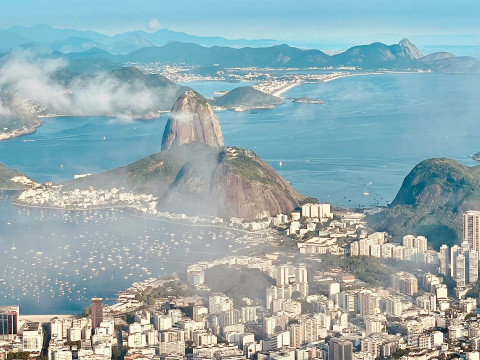
Five Brazilian cultural icons from the 20th century
28 February 2025
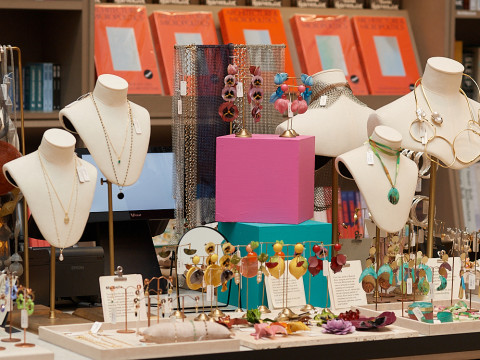
A love letter to the gallery gift shop
18 November 2024
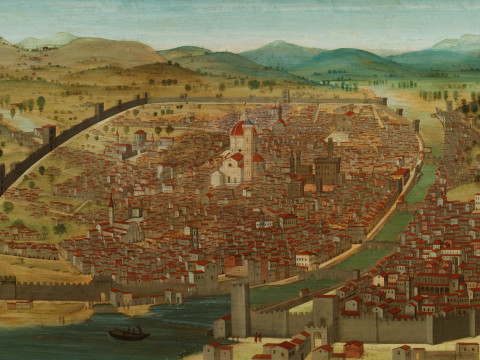
Painting the town: Florence in 1504
15 November 2024

Moving a masterpiece
7 November 2024
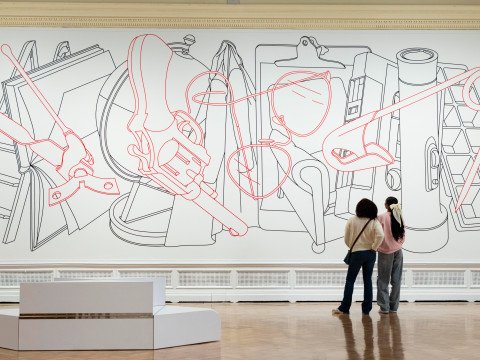
Video: drawing on gallery walls with tape
15 October 2024
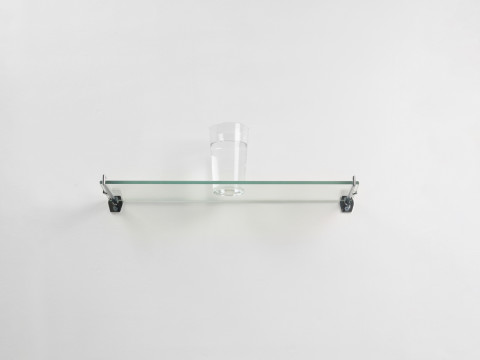
Video: changing a glass of water into an oak tree
15 October 2024